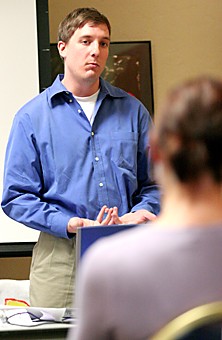The practice of slavery is still an ongoing concern throughout the world, even though it is often thought of as a historical problem, a guest speaker told students yesterday.
“”Slavery is illegal in every country in the world, but it is still being practiced throughout the developing and the developed world,”” said Tim Jefferson, Tucson office coordinator for the Arizona League to End Regional Trafficking.
Jefferson spoke in the Student Union Memorial Center as part of a speaker series sponsored by the UA Campus Greens; the eighth in a 10-part series of presentations emphasizing the 10 key values of the Green Party.
Ashley Weldon, the organizer of the event, said the club’s eighth value illustrated in yesterday’s presentation was feminism, which she said is at the heart of the issue of human trafficking.
“”This is largely a regional issue, and the majority of the victims are women or children,”” said Weldon, a UA women’s studies alumna who plans to begin graduate work at the UA in the fall. “”We thought this would be a nice way to incorporate feminism to something relevant to the Southwest and to students.””
Weldon said she invited Jefferson after hearing him speak at the Dinnerware Gallery in Tucson at an art exhibit inspired by women forced into prostitution.
ALERT is a state-run coalition that helps victims of human trafficking, as well as providing community outreach to raise awareness of the issue.
“”It’s an issue I have been aware of for a while and I thought the presentation was very well put together,”” said Kamaleeta “”Amanda”” Droopad, a business economics senior. “”It was good that he spent a lot of time defining the problem because a lot of people are not aware of the difference (between slavery and smuggling).””
Jefferson said that the Bush Administration and the media usually focus on slavery related to the sex trade, there are a number of other industries in the United States that routinely employ forced labor including construction, housekeeping and agriculture.
Unlike the chattel slavery of the American
Slavery is illegal in every country in the world, but it is still being practiced throughout the developing and the developed world.
Arizona League to End Regional Trafficking
South, modern human trafficking often involves luring individuals to the United States with false promises of citizenship and income. Jefferson said these practices make modern slavery a much more profitable enterprise for slaveholders than it was historically.
“”In 1850, it wasn’t uncommon for a person to pay between $1,000 and $1,800 for a single slave,”” Jefferson said. “”We have heard of people being sold into modern slavery in India for only $12.””
Another key difference is that while the slavery of the American South hinged on the belief of racial superiority over the enslaved, modern human trafficking does not follow any ethnic distinctions.
“”We have so many cases of Asians trafficking other Asians, Hispanics trafficking other Hispanics, Caucasians trafficking other Caucasians,”” Jefferson said. “”This isn’t a culture-specific problem.””
The U.S. State Department estimates that between 14,000 and 17,000 individuals are trafficked through the United States each year, Jefferson said, and most of these individuals are believed to pass across the border from Mexico into Arizona.
“”From working with a variety of agencies involved in crackdowns across the country, the vast majority list Arizona as their point of entry,”” Jefferson said.
But even with the number of humans trafficked across the Arizona-Mexico border, Jefferson said the state has yet to prosecute anyone, despite a new state law enacted last fall that specifically targets human trafficking.
“”Law enforcement agencies have been very honest in telling us that they simply don’t have the resources to investigate these cases,”” Jefferson said.
Jefferson said problems also arise because of confusion between human trafficking – where people are forced or tricked into being transported – and human smuggling – where someone pays to be transported across a border.
“”Even the governor, when signing the law, mixed up trafficking and smuggling in her speech,”” Jefferson said.









